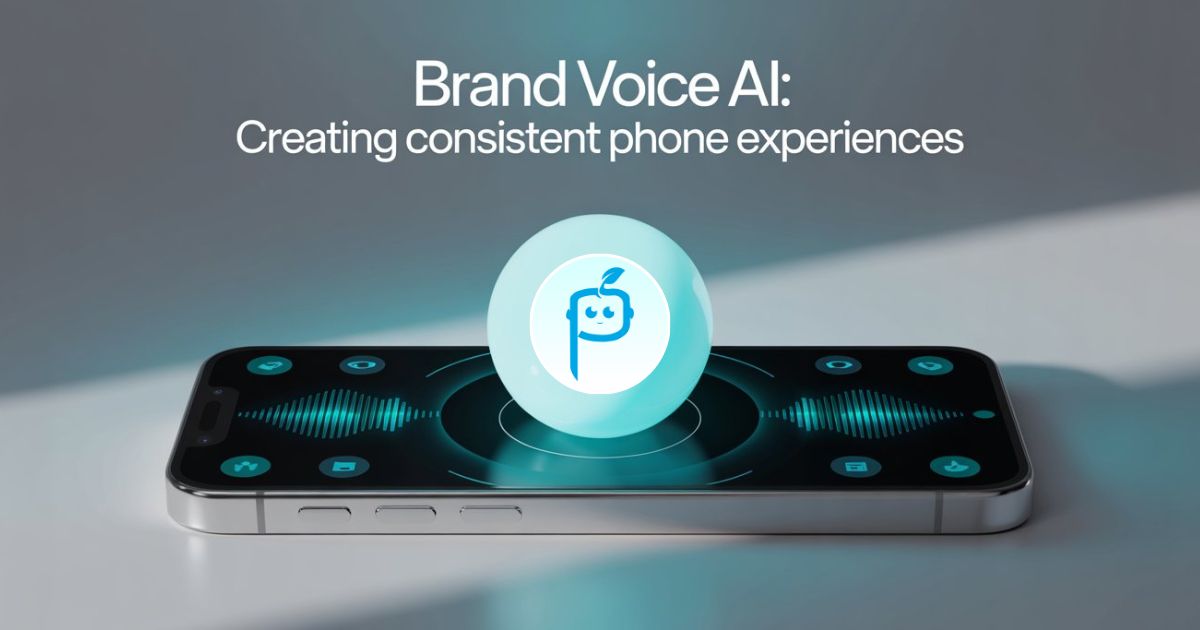Introduction
Your customers call your business expecting to hear your brand, not a generic robot. Yet most companies using voice AI sound the same – robotic, impersonal, and forgettable. The difference between brands that succeed with voice AI and those that frustrate customers comes down to voice AI customization for brands.
Table of Contents
Think about it. You wouldn’t use the same generic template for your website, social media, or marketing materials. Your brand has a unique personality, tone, and way of speaking. Your voice AI should reflect that same identity, creating phone experiences that feel authentically you.
The brands getting this right aren’t just using voice AI – they’re creating branded voice experiences that customers enjoy. Here’s how they’re doing it, and more importantly, how you can too.
Why Generic Voice AI Fails Your Brand
You’ll immediately recognize the brand experience at any Starbucks worldwide. The music, the décor, and the way baristas greet you reflect Starbucks’ carefully crafted identity. Now imagine calling their customer service and hearing a generic, robotic voice that could belong to any company.
That disconnect is exactly what happens when businesses use out-of-the-box voice AI without customization. Your customers experience a jarring shift from your carefully designed brand presence to a cold, impersonal phone interaction.
Generic voice AI creates several problems:
Brand Confusion: Customers can’t tell if they’ve reached the right company. When every business sounds the same, you lose the brand recognition you’ve worked so hard to build.
Trust Issues: People connect emotionally with consistent experiences. A robotic voice that doesn’t match your brand personality can make customers question whether they’re dealing with a legitimate business.
Missed Opportunities: Every customer interaction is a chance to reinforce your brand values. Generic voice AI wastes these opportunities, leaving customers with neutral (or negative) impressions instead of positive brand experiences.
Competitive Disadvantage: While your competitors sound like everyone else, a properly customized voice AI makes you instantly recognizable and memorable.
The solution isn’t to avoid voice AI – it’s to make it unmistakably yours.
The Psychology Behind Voice and Brand Connection
Humans are wired to respond to voices. Within seconds of hearing someone speak, we form judgments about their personality, trustworthiness, and competence. This psychological response doesn’t disappear when we’re talking to AI – it becomes even more important.
Research shows that voice characteristics directly impact how customers perceive brands:
Tone and Personality: A warm, friendly voice makes brands seem more approachable and customer-focused. A professional, confident tone builds trust and credibility. An energetic voice suggests innovation and excitement.
Consistency Builds Recognition: Just like visual branding, consistent voice characteristics help customers instantly identify your company. When your voice AI matches your brand personality, it reinforces recognition and builds familiarity.
Emotional Connection: Customers don’t just want their problems solved – they want to feel understood and valued. A voice that reflects your brand’s empathy and care creates stronger emotional connections than generic alternatives.
Cultural Resonance: Different regions and demographics respond to different voice characteristics. Customized voice AI can adapt to your target audience while maintaining your core brand identity.
Smart brands leverage these psychological principles to create voice experiences that don’t just work – they build relationships.
What Makes Voice AI Truly “Branded”
Creating a branded voice AI goes far beyond choosing a male or female voice. True voice AI customization involves multiple layers that work together to create a cohesive brand experience.
Voice Characteristics That Matter
Accent and Regional Variations: A Texas-based BBQ restaurant might use a subtle Southern accent, while a tech startup in Silicon Valley might opt for a neutral, educated tone. The key is matching your audience’s expectations and your brand’s geographic identity.
Speaking Pace: Fast-paced brands like fitness companies might use quick, energetic speech patterns, while luxury brands often prefer slower, more deliberate pacing that suggests thoughtfulness and attention to detail.
Pitch and Tone: Higher pitches often sound more approachable and friendly, while lower pitches convey authority and professionalism. The right choice depends on your brand personality and customer demographics.
Language and Communication Style
Vocabulary Choices: A financial services company might use terms like “assistance” and “consultation,” while a casual restaurant brand might prefer “help” and “chat.” These subtle differences reinforce brand positioning.
Sentence Structure: Some brands communicate in short, punchy sentences that sound dynamic and modern. Others use longer, more detailed explanations that demonstrate thoroughness and expertise.
Personality Expressions: How does your brand show empathy? Excitement? Professionalism? These personality traits should come through in how your voice AI responds to different situations.
Cultural and Demographic Alignment
Age-Appropriate Communication: A brand targeting younger demographics might use more contemporary language and expressions, while those serving older customers might prefer more traditional communication styles.
Professional vs. Casual Balance: B2B companies often need more formal voice AI, while consumer brands can be more relaxed and conversational.
Industry Expectations: Healthcare voice AI should sound knowledgeable and reassuring, while entertainment brands can be more playful and dynamic.
Practical Steps to Customize Your Brand’s Voice AI
Ready to create voice AI that actually sounds like your brand? Here’s how to approach the customization process systematically.
Step 1: Define Your Brand Voice Profile
Before you can customize voice AI, you need to clearly articulate your brand’s voice characteristics. This goes beyond your visual brand guidelines to include audio and conversational elements.
Create a Voice Personality Document: Write down five to seven adjectives that describe how your brand should sound. Examples might include “confident but approachable,” “knowledgeable yet friendly,” or “professional with a warm edge.”
Analyze Your Existing Communications: Look at your website copy, social media posts, and customer service emails. What tone and style do you already use? Your voice AI should maintain consistency with these established patterns.
Consider Your Audience: Who are you talking to, and how do they prefer to communicate? A brand serving busy executives needs different voice characteristics than one targeting college students.
Step 2: Choose the Right Voice Foundation
Gender Considerations: This choice often depends on your industry and target audience. Some sectors have traditional preferences, while others benefit from breaking expectations.
Age Perception: Younger-sounding voices might work for tech and lifestyle brands, while mature voices often suit financial and healthcare companies better.
Accent and Regional Factors: Consider where your customers are located and what accents they find trustworthy and relatable.
Step 3: Customize Speech Patterns
Develop Brand-Specific Phrases: Create a library of expressions that your voice AI can use consistently. Instead of generic responses like “How can I help you?” your restaurant might say “What delicious meal can we prepare for you today?”
Script Common Scenarios: Write out how your brand would handle typical customer interactions. Include greeting scripts, problem-resolution approaches, and closing statements that reflect your personality.
Build in Flexibility: While consistency is important, your voice AI should be able to adapt its tone based on the situation. A customer calling with a complaint needs different energy than someone placing an order.
Step 4: Test and Refine
Customer Feedback: Ask existing customers to interact with your voice AI and provide feedback. Do they feel like they’re talking to your brand, or could this voice belong to any company?
A/B Testing: Try different versions of key interactions to see which ones generate better customer responses and satisfaction scores.
Employee Input: Your team members understand your brand personality better than anyone. Get their feedback on whether the voice AI truly represents your company culture.
Industry-Specific Voice AI Customization
Different industries have unique requirements and opportunities for voice AI customization. Here’s how various sectors can leverage branded voice experiences:
Retail and E-commerce
Retail brands need voice AI that reflects their customer service philosophy and shopping experience. A luxury retailer might use sophisticated language and unhurried pacing, while a discount retailer could be more direct and efficiency-focused.
Key Customizations: Product-specific terminology, brand-appropriate enthusiasm levels, and checkout processes that match in-store experiences.
Healthcare and Wellness
Healthcare voice AI must balance professionalism with empathy, providing reassurance while maintaining credibility. The voice should sound knowledgeable without being intimidating.
Key Customizations: Medical terminology usage, patient privacy acknowledgments, and calming tone adjustments for sensitive conversations.
Financial Services
Financial brands need voice AI that inspires confidence and trust while remaining approachable enough for customers to feel comfortable discussing personal financial matters.
Key Customizations: Security-conscious language, clear explanations of complex processes, and appropriate formality levels for different customer segments.
Technology Companies
Tech brands often want voice AI that sounds innovative and knowledgeable while remaining accessible to non-technical users.
Key Customizations: Technical terminology balanced with plain language explanations, forward-thinking personality expressions, and problem-solving approaches that reflect innovation.
Hospitality and Travel
Hospitality brands need voice AI that embodies their service philosophy, whether that’s luxury pampering, adventure excitement, or family-friendly warmth.
Key Customizations: Destination-specific information delivery, service-oriented language patterns, and enthusiasm levels that match the travel experience.
Common Voice AI Customization Mistakes to Avoid
Even well-intentioned brands can stumble when customizing voice AI. Here are the most frequent mistakes and how to avoid them:
Over-Customization
Some brands get so excited about customization that they create voice AI that sounds forced or artificial. The key is enhancing natural speech patterns rather than creating completely artificial personas.
The Fix: Start with subtle customizations and gradually add more personality elements. Your voice AI should sound like a natural extension of your brand, not a caricature.
Inconsistency Across Touchpoints
Your voice AI might sound perfect, but if it doesn’t match your other customer service channels, you’ll create confusion instead of cohesion.
The Fix: Ensure your voice AI personality aligns with your website tone, email communications, and in-person customer service approaches.
Ignoring Cultural Sensitivity
What sounds friendly in one culture might seem too casual or even disrespectful in another. This is especially important for brands serving diverse customer bases.
The Fix: Research cultural communication preferences for your key customer segments and test your voice AI with diverse user groups.
Forgetting About Edge Cases
Most brands focus on common, positive interactions when customizing voice AI. But how should your brand sound when delivering bad news or handling complaints?
The Fix: Develop voice guidelines for difficult conversations, ensuring your brand personality comes through even in challenging situations.
Measuring the Success of Your Branded Voice AI
How do you know if your voice AI customization is working? Here are the key metrics that indicate successful brand voice implementation:
Customer Satisfaction Scores
Compare satisfaction ratings before and after implementing customized voice AI. Look for improvements in overall experience ratings and specific feedback about the interaction feeling “on-brand.”
Brand Recognition Metrics
Survey customers to see if they can identify your company based on voice AI interactions alone. Higher recognition rates indicate successful brand voice integration.
Completion Rates
Well-designed branded voice AI should actually improve task completion rates, as customers feel more comfortable and engaged with the interaction.
Repeat Usage
If customers prefer calling your customized voice AI over other contact methods, that’s a strong indicator that your brand voice is resonating.
Emotional Response Tracking
Monitor customer sentiment during and after voice AI interactions. Positive emotional responses suggest your brand personality is coming through effectively.
The Future of Brand Voice AI Customization
Voice AI customization is rapidly evolving, with new capabilities emerging that will make branded experiences even more sophisticated and personalized.
Dynamic Personality Adjustment
Advanced voice AI systems will soon be able to adjust their personality in real-time based on customer behavior and preferences, while still maintaining core brand characteristics.
Multilingual Brand Consistency
Future systems will maintain brand voice characteristics across different languages, allowing global brands to sound consistent whether customers are speaking English, Spanish, Mandarin, or any other language.
Emotional Intelligence Integration
Voice AI will become better at reading customer emotions and adjusting brand personality expressions accordingly – being more empathetic during stressful calls while maintaining brand authenticity.
Voice Biometrics and Personalization
As voice recognition improves, AI systems will be able to recognize returning customers and adjust their brand personality to match individual preferences while staying true to core brand values.
Getting Started: Your Brand Voice AI Action Plan
Ready to transform your phone experiences with customized voice AI? Here’s your step-by-step weekly action plan:
1-2: Brand Voice Audit
- Document your current brand voice across all channels
- Identify gaps between your brand personality and current phone experiences
- Survey customers about their expectations for phone interactions
3-4: Voice Profile Development
- Create detailed voice personality guidelines
- Develop scripts for common interactions
- Choose voice characteristics that match your brand
5-6: Implementation and Testing
- Work with your voice AI provider to implement customizations
- Test the system internally with team members
- Refine based on initial feedback
7-8: Launch and Monitor
- Roll out to a subset of customers first
- Gather feedback and satisfaction data
- Make adjustments based on real-world usage
Ongoing: Optimization and Evolution
- Regularly review performance metrics
- Update voice characteristics as your brand evolves
- Stay current with new customization capabilities
Making Every Call Count
Your phone isn’t just a communication tool – it’s a brand touchpoint that can either strengthen or weaken customer relationships. With proper voice AI customization, every call becomes an opportunity to reinforce your brand values, build trust, and create memorable experiences.
The brands that get this right won’t just have better customer service – they’ll have a competitive advantage that’s impossible to ignore. When customers can instantly recognize your company by voice alone, when they enjoy calling your business, and when your phone interactions reinforce the same brand experience they get everywhere else, you’ve created something powerful.
Don’t let a generic voice AI dilute your brand. Invest in customization that makes every phone conversation unmistakably, authentically yours. Your customers will notice the difference, and your business will reap the rewards.
Read More: Advanced AI Voice Assistant For Call Centers Beats iOS 26
Conclusion

Voice AI customization isn’t a luxury; it’s a necessity for brands that want to create consistent, memorable customer experiences across all touchpoints. Start building your branded voice AI today, and transform every phone call into a brand-building opportunity.






[…] Read More: Brand Voice AI: Creating Consistent Phone Experiences […]
[…] the best voice AI systems ranked requires understanding critical evaluation criteria. Voice quality determines customer satisfaction […]